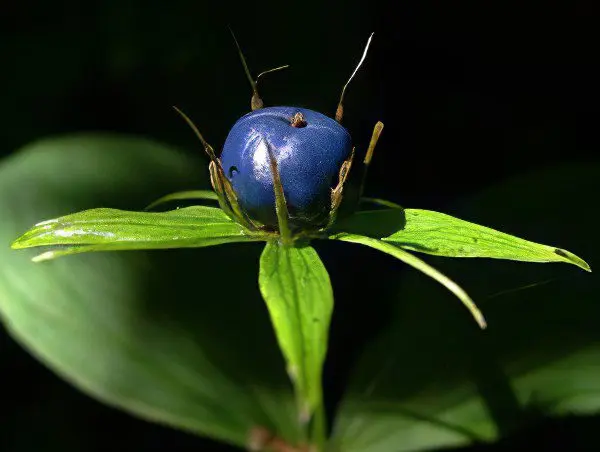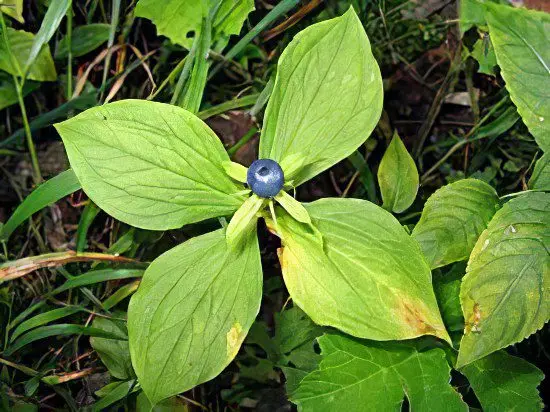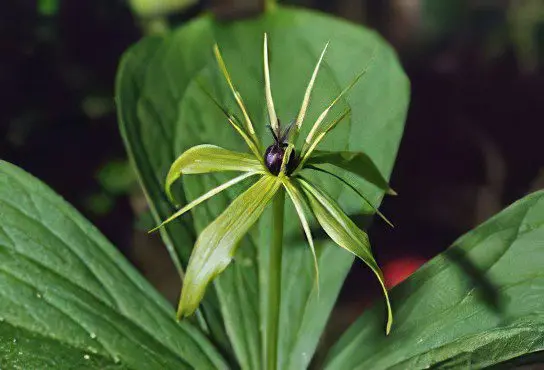Treatment with drugs from the crow’s eye. Signs of poisoning
What does a raven eye look like?

Vorony Eye – a perennial plant, the height of which is not more than 40 cm. The rhizome of the plant is creeping and very long. The straight and smooth stem does not have leaves at the bottom, but on its upper part one can see a whorl consisting of four leaves. The leaves are oval or ovate, the ends of the leaves are pointed, the arrangement of the leaves is crosswise. On the pedicel is a single apical flower of yellow-green color. The composition of the flower includes 4 petals and 4 sepals.
The fruit of the plant is a black berry containing many seeds. The raven eye begins to bloom in May and ends in June. The fruits ripen in late July – early August.
This poisonous plant can be seen almost throughout Europe, in Western and Eastern Siberia, in the Caucasus. It grows in the forest and forest-steppe zone, or rather, in broad-leaved and coniferous forests, in the middle of the bush. The raven eye prefers damp and shady places.
Many have heard that the raven eye is a poisonous plant, but it is used as a medicine. The aerial part of the crow’s eye is used to prepare tinctures and decoctions. You will be surprised, but even fresh, unripe berries are also harvested and used as a remedy.
Useful properties of the crow’s eye
The rhizomes and berries of the crow’s eye are very poisonous. The whole plant contains saponins, steroids, pyridine glycoside. The herb has been found to contain substances called “flavonoids”, and the herb also contains coumarins and vitamin C. The rhizomes are rich in alkaloids.
Crow’s eye can only be used after consulting a doctor. The specialist will determine whether you really should take preparations of this plant, and if so, in what doses. The plant has anti-inflammatory, diuretic, sedative, antispasmodic and wound healing effects on the human body.
Application of the raven eye

In medicine, the raven eye is used unofficially, although there are medicines based on it that help people heal. There is one “but”: it is possible to take raven eye preparations, but the dose must be homeopathic and the doctor must approve it. Preparations from the crow’s eye are used for inflammation of the larynx, eye diseases, neuralgia, and the juice from a fresh plant helps with loss of vision, headache, bronchitis and drowsiness.
Tinctures and decoctions from the crow’s eye should be taken very carefully, do not forget that the plant is poisonous.
Decoctions of the crow’s eye relieve spasms that are caused by nervous disorders, help with fever and dropsy.
In case of metabolic disorders, dizziness, laryngitis, mental disorder, tincture of the crow’s eye, prepared with alcohol, helps.
Crow’s eye herb tincture. Take 2 grams of fresh, but crushed plant grass and fill them with half a glass of 70% alcohol. Leave the composition to infuse for one week. Be sure to pass. Next, take a glass of water and dilute 1 tablespoon of the finished tincture in it. If there are signs of nervous excitement, then you need to drink the tincture every 1,5 hours, but you can not drink more than 200 ml of the drug per day.
Infusion from the collection. It is prepared in the following way. They take the same amount of crow’s eye grass, blue cornflower, open shoot grass, meadow clover flowers, geranium and bird cherry flowers. All these components should be mixed well. Now you need to take 1 tablespoon of this collection and pour 200 ml of boiling water over it, then insist for an hour. After insisting, it is necessary to strain the infusion. Apply such a remedy as a lotion for blepharitis or conjunctivitis.
Crow’s Eye Recipes
Recipe number 1. To prepare the tincture, take 2 grams of fresh, carefully chopped grass of the plant, pour 70% alcohol (half a glass). The container should be closed and put in a dark place for 7 days, then strain. The resulting product is taken in a diluted form with water – for 1 tablespoon of infusion 1 glass of water. Reception scheme: for a nervous tic, dilute 2 tablespoons of the tincture of the leaves prepared according to the indicated recipe in a glass of boiled water and drink 1 tablespoon every 2 hours during the day until the annoying tick under the eye or other similar twitches in the body pass completely. Sometimes a few doses of the medicine are enough for the tic to go away.
Recipe number 2. This medicine is prescribed by a doctor for a concussion. To prepare the tincture, you need to take 4 cups of raw materials (dried crow’s eye grass) and pour vodka (500 grams). The container must be closed and put in a warm, dark place for 9 days, then strain. The resulting tincture is recommended to be taken diluted with water – 5 drops of 50 grams of water – 2-3 times a day.
Crow’s Eye Berries
The ripening of the berries of the crow’s eye occurs in July-August. Berries are highly poisonous, they are dangerous for both humans and animals due to their content of paradin and paristifin. However, they contain useful substances that have a therapeutic effect on the human body.
The berries of the crow’s eye, despite the toxicity, are used in folk medicine to treat, first of all, heart diseases (heart failure, tachycardia, arrhythmia, and other diseases). In addition, berries are an effective tool in the treatment of pulmonary tuberculosis, metabolic disorders, neuralgic diseases, ascites. With the help of tinctures from these berries, laryngitis, migraine, sweating, hernia, and drowsiness are treated.
Tincture recipe. It is prescribed for heart failure (with edema). It is necessary to take 10-12 fresh berries of the crow’s eye, pour vodka (500 grams), close the container, put in a dark place and leave for 15 days. Reception scheme: 1-20 drops of tincture should be taken for 30 dose, diluted in 50 g of water, the number of doses is three per day. The course of treatment is 3 weeks. After a break of 10 days, if necessary, the course can be repeated.
This tincture is also recommended for diseases of the nervous system. It is recommended to take it according to the following scheme: dilute 1 tablespoon of tincture in a glass of water, it is important to drink 1 tablespoon every 1,5–2 hours. Do not take more than one glass a day!
The raven eye is a poisonous plant
The raven eye is a poisonous plant, it contains substances such as paradin and paristifin. Crow’s eye berries, when eaten, are dangerous for humans and animals. The leaves of the plant are the least dangerous, and its berries are the most dangerous. If you eat up to two berries, the body most likely will not react negatively to this product. With more use, vomiting, colic, diarrhea, dizziness, convulsions are noted, the heart works differently (worse than before), it is difficult to breathe, paralysis. If the above signs are observed, then there is a fact of poisoning with a crow’s eye.
Considering that the plant is known for its healing properties, it is recommended that treatment be carried out exclusively under the supervision of a doctor in order to avoid cases of poisoning. The raven eye affects the organs of the gastrointestinal tract.
In case of poisoning, it is necessary to wash the stomach from the poisons present, namely, give the poisoned person pieces of ice, let him hold it in his mouth (this is like an antidote). Inside you need to enter anesthesin and some drug that will restore the work of the heart, for example, strophanthin.
raven eye flower

The flower of the raven eye is solitary, located at the top of an erect stem. In the center of the flower there is a ball of ovary, painted in a dark purple hue, from which eight narrow stamens, four narrow inconspicuous petals and four green sepals extend (the size of the sepals is slightly larger than the petals). After the completion of the flowering process, a rather large black-blue (blue-black) berry is formed from the ovary.
The flowering period of the crow’s eye falls on May-June. For traditional medicine, the flower of this plant is of no value, therefore, it is not used in the formulation of infusions and decoctions. Like all other parts of the crow’s eye, the flower is poisonous and should be handled with extreme care.
Crow’s eye four leaf
The four-leaved raven eye is a perennial herbaceous plant of the lily family (some new sources refer the plant to the melanthium family). Rhizome long, creeping. Stem – solitary, erect; the lower part of the stem is bare (without leaves), in the upper part there is a whorl of 4 leaves (rarely 3, 5 and 6). Leaves – oval or ovoid, entire, short-petiolate (sessile), arranged crosswise, pointed at the end; they are dyed green.
The flower is solitary, inconspicuous, located in the upper part of the stem, star-shaped, painted in a yellow-green hue. In the center of the flower there is an ovary, from which, at the end of flowering, a fruit is formed – a blue-black multi-seeded berry of a rounded shape. The four-leaved raven eye blooms in May-June, bears fruit in July-August.
The natural distribution area of this species is almost everywhere throughout Europe (except for the arid southern regions), in Eastern and Western Siberia and the Caucasus. This plant grows mainly in deciduous and coniferous forests, in dense thickets of bushes, as well as in dark and humid places.
All parts of the plant are poisonous (berries and rhizomes are of particular danger), but this did not become an obstacle for folk healers who have been using the aerial part of the plant (grass and berries) for the treatment of various diseases for a long time. Crow’s eye grass is harvested during the flowering period and is used for the preparation of infusions and tinctures, mainly fresh; berries are harvested after ripening – in August.
Self-medication with healing infusions and tinctures of this type of plant can lead to undesirable consequences, therefore, before starting the use of such medicines, consultation with your doctor is necessary.
Crow’s eye herb is used in the treatment of migraines, neuralgia, ascites, pulmonary tuberculosis, metabolic disorders and in case of convulsions. Berries are used for diseases of the cardiovascular system.
Contraindications to the use of the crow’s eye
All parts of the plant are poisonous, especially berries and creeping rhizomes, for this reason, medicinal tinctures and infusions should be used with extreme caution, not exceeding the indicated dosage and only after consulting with your doctor. Crow’s eye drugs are not used during pregnancy, during breastfeeding, in children under the age of 12, with hypertension and insomnia.









